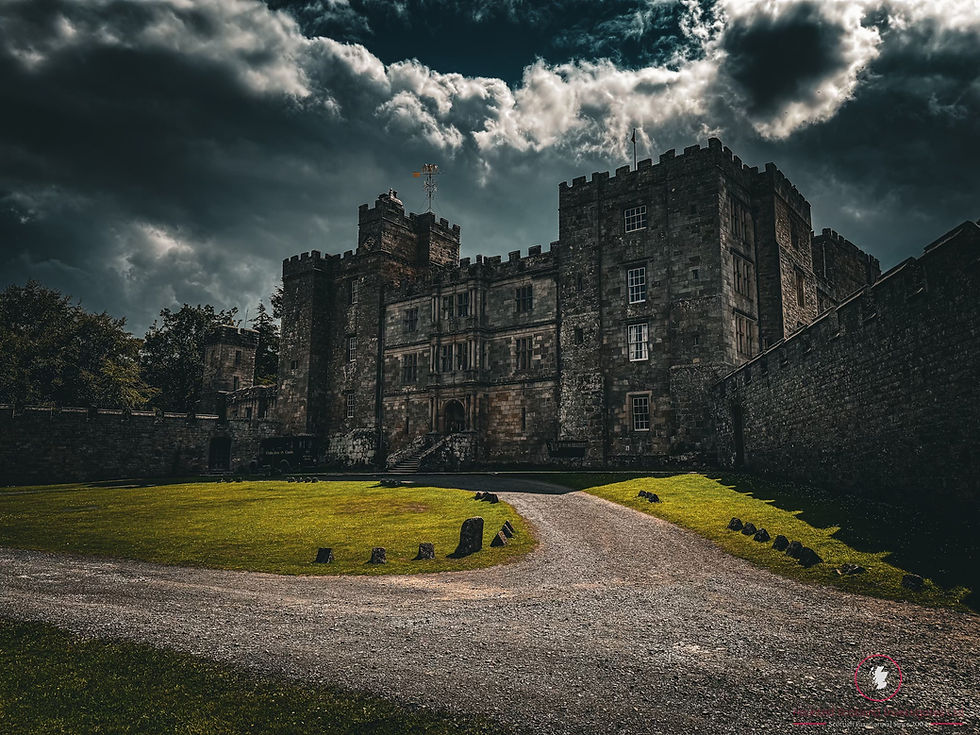The Spanish Witch of Chillingham Castle
- Greg Stewart
- Aug 4
- 4 min read
As is no doubt the case for many people, I initially heard mention of the Spanish Witch when I first visited Chillingham Castle many years ago. After our most recent return to the castle, which included a 4 hour investigation, the tale of the castle's curse once again cropped up. With that in mind, I decided to delve deeper into the story.

Who is the Spanish Witch
The question should perhaps be what, rather than who. The term 'The Spanish Witch' relates to a painting hanging in the Still Room at Chillingham Castle. A Still Room in a castle normally relates to a room used for the storage and preparation of items such as tea, preserves and liquor by the house staff and, given that the room bearing this name at Chillingham led directly to the dungeon, it seems unlikely to me that this was its original use.
The painting itself appears old, with some resources indicating it dates back to the 17th century, and depicts a dark haired woman considered to be Mediterranean in appearance, which seems to be the only real connection to Spain.
Legend tells that the portrait depicts a woman who was held and executed in the castle, some versions claim it took place in the room where the painting now hangs. Just before she died, it is said she uttered a curse to bring bad luck upon anyone who steals from the castle. It is believed that the painting now holds a protective energy, and anyone who takes anything from the castle will be plagued with bad luck until such time as the item is returned. A number of items lie around, said to be items that were removed and later sent back, along with letters of apology said to have been written by the perpetrators describing a series of bad luck that befell them after they had taken the item, and begged for the curse to be lifted.

The story is certainly intriguing, with the written apologies seeming to support it, and so it is easy to understand why it captures the interest of so many who hear it.
The Origins of the Story
As always, when considering such tales, it is important to look back to the origin. It seems no one is quite sure when the painting arrived at Chillingham. Some resources indicate it was found hanging on the wall, where it still remains, when the current owner took possession of the property in the 1980s. By that time, the building was in a virtually ruinous condition, yet intriguingly the painting is said to have been relatively undamaged with no signs of the significant deterioration that its surroundings had suffered. This starts to sound similar to another allegedly cursed picture, the legend of the Crying Boy, the infamous portraits that are said to survive house fires that destroy the building around it.
While the question of whether the painting was in the castle at the time of its purchase, or whether it was added to dress the room during the subsequent total and sympathetic restoration of the property is unclear, what is notable is that there does not appear to be any mention of it, or any alleged curse connected to it, in earlier writings about the castle's haunting history.
Irrespective of how and when the tale of the protective energy surrounding the Spanish Witch painting started, it had to start somewhere. This seems to have been when the castle was opened as a tourist attraction. It may be that during the restoration work, contractors helped themselves and suffered bad luck, or personal documentation from previous owners was unearthed or even if the portrait was brought into the castle as part of the restoration, it may have already had the back story of protecting wherever it’s hung. While the numerous items said to have been returned along with apologies certainly seem to support the legend, we have no details of how many people have removed something with no ill effects for comparison, making it impossible to gauge.
Yet one of the main questions about the story that jumps to my mind is why would anyone who had been held and subsequently executed at the castle, issue a curse in their dying breath to protect both the property and the possessions of its occupants? If someone had such power, surely they would use it to avenge their harsh treatment? It doesn't seem to make sense.
Truth or Myth?
Despite the conflicting thoughts regarding the alleged curse, there is no denying some people who have removed an item have encountered what they believe to have been the effects of it. And we should never forget the power of the mind. When we convince ourselves of something, we inevitably look for evidence of it, and so anyone who has removed an item either with full knowledge of the curse, or who later hears of it, may begin to attribute any ill fortune to their actions. The belief is also something that benefits the owners of the castle to prevent anything being taken, and so it is understandable they may want visitors to be aware of it.

With all that said, I still find the tale of the Spanish Witch an intriguing one. There is now a strong belief in the power of the painting, along with the very real experiences of some who removed items, which cannot be negated. As I mentioned earlier, all stories have to have an origin. Just because an origin is difficult to verify, doesn't completely invalidate the story. Personally, I would certainly not remove anything from the castle, although that is more from respect to the owners, the staff and the magnificent structure itself rather than any fear of a curse.


![[PREMIUM] Chillingham Castle](https://static.wixstatic.com/media/4cccc3_9b8e2a7c5c314a2784c3a9b4c8290b04~mv2.jpg/v1/fill/w_980,h_735,al_c,q_85,usm_0.66_1.00_0.01,enc_avif,quality_auto/4cccc3_9b8e2a7c5c314a2784c3a9b4c8290b04~mv2.jpg)
Comments